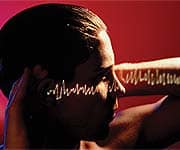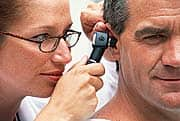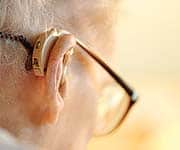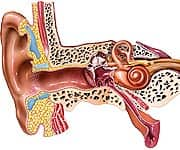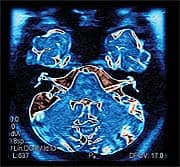Life Extension Magazine®
Alarmingly, nearly half of all baby boomers today suffer from some degree of hearing loss. While its onset can be almost imperceptible, the end result is an impaired ability to interact with the world that significantly detracts from quality of life. For more than 20 years, leading otolaryngologist Dr. Michael Seidman has been searching for the underlying causes of age-related hearing loss and for natural strategies to prevent and even reverse this debilitating condition. His remarkable research and clinical experience shows that it is now possible to slow the progression—and sometimes even reverse hearing loss—using an integrative approach that includes optimal nutritional and lifestyle choices. In the following excerpt from Save Your Hearing Now (Warner Wellness, 2006), Dr. Seidman reveals the intimate link between aging and hearing loss, and how you can implement a program today to protect your hearing against the ravages of aging. After treating hundreds of patients suffering from hearing loss— and seeing the devastating effects it had on their lives—I decided to look for a natural solution. Knowing that antioxidants counteract the damage caused by free radicals, I thought there might be a way to use those same safe, natural substances to protect and/or restore hearing. But first, the fact that there was a link between free-radical damage and hearing loss had to be established. So the first study my colleagues and I conducted was designed to find out if there was a connection between damaged hearing in humans and the common hearing loss seen with aging. To measure free-radical damage, scientists can look for certain “markers,” chemical or cellular signposts that indicate change within a cell. In humans, one of these markers is known as the common aging deletion. It is a sign of both advancing years and free-radical damage to the DNA of tiny organelles within each cell known as mitochondria. From previous research in our lab and by others, we knew four things:
To test the theory that aging damages hearing and common aging deletions are a sign of that damage, we examined the temporal bones (those found at the sides and base of the skull) of thirty-four individuals, seventeen with normal hearing and seventeen who had age-related hearing loss. Temporal bones house the cochlea, the snail-shell-shaped organ responsible for hearing, and this is why we focused on that particular area. We found the common aging deletion in fourteen of the seventeen individuals with hearing loss and in eight of those with normal hearing. Why didn’t the deletion appear in all seventeen of those with hearing loss? And why did it appear in bones of people whose hearing was fine? At least two reasons: The common aging deletion is only one type of hearing loss. It could be that other deletions contribute to hearing loss, too. In addition, there are four different types of age-related hearing loss. The common aging deletion may not be responsible for all four. At any rate, this study provided us with enough evidence to conclude that the common aging deletion is associated with aging and hearing loss.5 Supporting the First Findings
The link between aging and hearing loss was underscored by our next study. It involved a number of rats, which were divided into four age groups: young, mid-young, mid-old, and old. We tested the sensitivity of rats’ hearing and examined their DNA for the common aging deletion, to determine if there was an association between the two. We found that, like humans, rats tend to have higher levels of the common aging deletion as they grow older, and they have an increased tendency to develop hearing loss as well.6 Now we had established that the aging process resulted in an increase in common aging deletions, which weakened the mitochondria and damaged hearing. But could the damage be slowed, prevented, or possibly even repaired with supplements of naturally occurring antioxidants? That’s the question we set out to answer with two additional studies. In one clinical trial, we followed animals from approximately several months old to the day they died. One group received a calorie-restricted diet, shown to reduce free-radical production, reduce mitochondrial damage, and to increase life span. For purposes of comparison, a placebo-controlled group was allowed to eat freely. Other groups were treated with antioxidants, including vitamins E and C, and the hormone melatonin. With this study, we demonstrated that free radicals and damage to the mitochondria that occurs with aging leads to presbycusis, the medical term given to agerelated hearing loss. Furthermore, we were able to demonstrate that dietary moderation and specific nutrients reduce the progression of age-related hearing loss, and we concluded that it is likely that a combination therapy would provide a synergistic protective effect on presbycusis and possibly on aging as well.7 But even more dramatic results occurred in our next clinical trial. In this study, we used twenty-one two-year-old rats, senior citizens in the rodent world, and divided them into three groups of seven each. For six weeks, one group was given ALC (acetyl-L-carnitine), the second was given ALA (alpha-lipoic acid), and the third group, used as a control, received a placebo (sugar pill). When we tallied the results, it was clear that hearing in the control (placebo) group had deteriorated at a rate typical for animals of that age. But that didn’t happen with either group of supplemented animals. Instead, we discovered the ALA and ALC did something pretty amazing. The supplemented rats not only avoided hearing loss, but their hearing actually improved. In other words, supplements didn’t just stop age-related hearing loss—they reversed it!8 During the study, the control group lost anywhere from 3 to 7 dB of hearing, while the ones treated with ALC or ALA had a 7 to 10 dB improvement in their hearing, with the greatest improvements occurring after six months of treatment. While the ALA was more effective for protecting hearing at low frequencies, ALC did better at higher frequencies. We demonstrated that taking both supplements is the best way to protect against hearing damage in general. Of all the research I’ve done, I consider this study the most important. It clearly demonstrates that hearing loss can be prevented—and even reversed—by simply taking a combination of antioxidants that includes ALA and ALC. Both these substances have been popular in Europe for some time, and are widely considered nontoxic, very effective in treating hearing loss, and also capable of providing overall antiaging and wellness benefits. But there is another reason this study stands out. Medical research is full of surprises. Sometimes what makes perfect sense on paper just doesn’t work in the lab. Other times we are literally astonished by the unanticipated benefits. That’s what happened in this particular study. Along with improved hearing in the supplemented animals, we found a much lower level of common aging deletions in the mitochondria all throughout the body. The supplements actually reduced the amount of free-radical damage everywhere, creating an antiaging effect that improved hearing and carried over to other cells throughout the body. In other words, we had proven that age-related hearing loss can be reversed in mammals, with allnatural, side-effect-free substances. Although this research was groundbreaking at the time, other scientists have since shown that ALA, ALC, and various other substances, including the antioxidant coenzyme Q10 (CoQ10) and glutathione, provide substantial protection for the mitochondria and thereby support healthy hearing.
How Aging Affects Hearing
Age-related hearing loss affects approximately one-third of all people aged sixty-five and older. Technically known as presbyacusia or presbycusis, age-related hearing loss is due to the changes that occur in the body as we grow older. Circulatory disorders, for example, which limit the flow of blood throughout the body, as well as to the brain and auditory system, are common in later years. There are any number of reasons why circulation slows down as we grow older, among them heart disease, hardening of the arteries, diabetes, and sedentary lifestyles. My research and that of many colleagues clearly show that the same things that protect us from the damage done by passing years also prevent damage to our hearing. In order to understand how hearing can be saved by slowing the clock, let’s take a look at the aging process and what happens in the body, especially the auditory system, as time passes. Aging Begins in the CellsDuring a normal lifetime, our cells divide anywhere from twenty to thirty times. This ongoing process of cellular expansion turns a child into an adult, and then cell division slows. Ultimately, because of inherent limits, our cells are no longer able to divide. So although we continue to need new cells, later in life our bodies are not as efficient as they once were at producing them. The result: Disease or malfunctions occur because faulty cells are not replaced with fully functional versions. In addition to the inherent limitations on new cell production, other factors are thought to play a role in aging. There are several different theories about the process, including the free-radical or mitochondrial clock theory, dysdifferentiation theory, and the telomerase theory. Thus far, the free-radical theory hasthe widest acceptance. The Enemy: Free RadicalsIn simplest terms, a free radical is an unstable molecule or cluster of molecules that is missing an electron. Like mini-atomic bombs, free radicals damage or destroy cells they come in contact with. Free radicals are by-products of everything from eating to living in a world filled with toxic chemicals and pollution. In other words, they are unavoidable. Although some free radicals are actually beneficial, others damage healthy cells. Free radicals can cause errors in genetic “messages” by altering DNA (deoxyribonucleic acid, the “blueprint” that governs cell growth). This can, among other things, lead to a reduced blood supply to organs such as the inner ear and brain, thereby damaging hearing. When one of these loose cannon free-radical molecules binds with a healthy cell, it wreaks havoc on the cell’s ability to function. Mother Nature did not leave us completely defenseless, though. Our bodies produce enzymes known as antioxidants—such as superoxide dismutase (SOD), catalase, and glutathione peroxidase—to counteract the damage. We can also obtain antioxidants from certain foods and supplements. But if inadequate production or a poor diet results in a shortage of antioxidants, cellular damage may not be repaired, and sooner or later, we become ill. There have been many studies documenting that free radicals are responsible for more than a hundred human diseases, including Alzheimer’s, cancer, heart attacks, strokes, and arthritis, as well as aging. Even though free radicals are microscopic and exist for far less time than it takes to blink an eye, they are capable of doing considerable damage simply because of their sheer numbers. According to research at Emory University, each human cell receives approximately ten thousand free-radical hits each day. Further calculations have shown that this equals 7 trillion (7,000,000,000,000!) insults per second throughout our bodies.9 Certainly, 7 trillion is a staggering number, but the body counteracts this assault with its own arsenal of antioxidant enzymes. Unfortunately, there is a significant decline in these enzymes as we grow older. In fact, we now know that by the time the average person reaches the late twenties, production of these detoxifying enzymes has declined dramatically. Based on the findings of scientists studying free radicals and human health, the best approach to slowing aging is one that provides the body with plenty of antioxidant ammunition against free radicals. That means increasing intake of antioxidants, something that can be done in part with the proper diet or, more effectively, by taking supplements. The Mighty MitochondriaTo measure free-radical damage, scientists can look for certain “markers,” chemical or cellular signposts that indicate change within a cell. In humans, one of these markers is known as the common aging deletion. It is a sign of both advancing years and free-radical damage to the DNA of tiny organelles within each cell known as mitochondria. About 98 percent of our body’s energy is produced in mitochondria, so they are often described as the cells’ powerhouses. A number of studies have shown that the functions of the mitochondria decrease with age, leading some experts to speculate that this may be why many people feel less energetic as they grow older. The hardworking mitochondria also serve as the cells’ “gatekeepers,” with the power to determine whether a cell lives or dies, so it’s doubly important to keep the mitochondria healthy.10 The mitochondria have their own DNA, which is completely separate from the DNA found in the cells. When free radicals ravage the cellular DNA, it can be repaired, but the mitochondria’s cannot. The mitochondria can be weakened or may even die, creating a slowdown in many essential processes. Even an incredibly small mutation in the mitochondrial DNA can dramatically slow energy production. In fact, the drop in mitochondrial activity is the basis of the free radical or mitochondrial clock theory of aging. According to this theory, the aging body increases its production of free radicals, which damage the body’s tissues and subcellular elements, such as the mitochondria. When we see the common aging deletion in mitochondria, we know the cells’ little energy factories aren’t fully functioning. The Lifestyle ConnectionIn addition to providing the body with adequate amounts of antioxidants and other important nutrients, we’ve also discovered that there are several other things we can do to slow aging and save hearing. Living on Less: The Lowdown on Caloric RestrictionA major aspect of the lifestyleaging connection is the food an individual chooses to eat. Research going back more than seventy years shows that “caloric restriction,” the term given to lowcalorie, high-nutrient diets, extends the life span of laboratory animals and insects by up to 50 percent. In fact, nearly two thousand studies have confirmed the connection between caloric restriction and extended life span in a number of different species. The average protozoa on a normal diet, for example, are typically alive for seven to fourteen days. On a caloric-restriction program, though, the average protozoan life span is thirteen days and can go as long as twenty-five, nearly double the maximum with a standard diet. Caloric restriction is currently a hot topic among scientists studying longevity, primarily because it works so well. Based on what we know now, to achieve life extension results, we would have to eliminate 30 percent or more of our daily calorie intake. According to the Calorie Restriction Society (http://www.cron-web.org), four daily meals should add up to no more than 1,700 to 1,800 calories. It probably wouldn’t hurt most of us to cut back a little at mealtime, though. And it is possible that hearing could improve as a result, because caloric restriction is shaping up as a means of protecting more than the waistline. The benefits of skipping extra calories appear to extend to the brain, where much of the auditory system is located. A recent animal study at the University of Wisconsin, Madison, reported in Nature Genetics, demonstrated that a reduced-calorie diet actually protects brain cells from deterioration caused by aging, the very types of changes that could lead to Alzheimer’s and other degenerative conditions.11 In fact, two other studies that examined patients with Parkinson’s determined that highcalorie diets were linked to the likelihood of developing the disease.12 So skip the dessert and do your waist— and your brain—a favor. The good news is that you don’t have to starve yourself to save your hearing. | ||||||
How Weight Harms HearingHow is obesity or excess weight related to hearing? Although that subject is only beginning to be studied, Swedish researchers did find a connection recently. They followed nearly three hundred Swedish women over a twenty-four-year period. Using various data, including physical exams and brain scans, they found the first evidence that those with a high body mass index (BMI) throughout adult life had lost brain tissue when compared to women with lower BMIs. Loss of brain tissue occurred in the temporal lobe portion of the brain, where the auditory system is located, along with language, speech, memory, and comprehension.13
Why would weight affect the brain? There are three possible answers to that question. One, excess weight could increase the number of damaging free radicals in the body. Two, fat may produce harmful substances, such as growth factors and hormones, which can erode brain tissue. And three, excess fat might be responsible for hardening of the arteries (atherosclerosis) and result in limited oxygen flow to the brain. Another connection between obesity and hearing loss is suggested by recent findings from Great Britain linking excess weight with accelerated aging. In a study involving more than eleven hundred women, scientists found that obesity had a greater effect on markers of aging than smoking. Among women who were obese, the markers showed signs of aging that were the equivalent of nearly nine years beyond those who were lean. Not surprisingly, being overweight or obese increases freeradical levels in the body, which the experts believe to be the reason more signs of aging were seen in those of excess weight.14
How Drugs Damage Hearing
Good nutrition and moderate physical activity have repeatedly been shown to improve symptoms in a host of conditions that are typically treated with pharmaceuticals, including depression, anxiety, arthritis, heart disease, diabetes, and high blood pressure. Some people find that making lifestyle changes allows them to use less medication, while others are able to work with their physician to gradually eliminate drugs completely. It is a little known fact that many commonly prescribed drugs are ototoxic, or damaging to hearing. There are hundreds of ototoxic drugs, including popular nonsteroidal anti-inflammatory drugs (NSAIDs), like aspirin, as well as some antidepressant and antianxiety drugs, to name a few. Typically, people taking these medications have no idea that their hearing could be affected. Moreover, since the hearing loss may not appear until months after beginning the medication, the connection is far from obvious. The medication is rarely suspected to be the source of the problem, and every prescription refill continues the hearing damage. A younger person may have more resistance to drugs that damage hearing, and is more likely to be taking only one or two medications at a time. Increasingly, though, older people are prescribed multiple remedies for a host of ailments that occur later in life. Often, these medications are prescribed by different doctors, who may not be aware of the total number of medications the patient is taking. The compound effect of taking multiple drugs—and its impact on hearing— are completely unknown. But certainly, if an individual is taking more than one ototoxic medication— and one is all it takes to damage hearing— we can assume the results are not going to be good. Popular Drugs and Hearing DamageLiterally hundreds of drugs can affect the ability to hear, including popular nonsteroidal anti-inflammatory drugs (NSAIDs), like aspirin. In many cases, large doses or abuse of a drug can cause hearing loss, but when the same medication is taken as prescribed, it does not harm hearing. In normal doses, aspirin, for example, is considered safe, but those individuals who believe that “more is better” may be risking their hearing. Other commonly prescribed drugs that affect hearing are:
Keep in mind that hearing loss is not the only effect these substances may have on the auditory system. Tinnitus and problems with balance may also occur. In fact, individuals with tinnitus should be certain their physician is aware of their condition and request prescriptions that will not make the condition worse. Drugrelated hearing loss, as well as tinnitus and balance problems, may be temporary or permanent, depending on a number of factors, such as dosage and length of time the drug is taken. What This Means to Us HumansThe research my colleagues and I have done, which has been thoroughly reviewed by other experts and published in leading medical journals, clearly demonstrates that we can slow the progression of―and in some cases, reverse―hearing loss with natural substances found in food and supplements. The Save Your Hearing Now Program is designed to do just that. Scientifically proven antioxidant supplements and nutrients to enhance mitochondrial function are the program’s foundation. A Mediterranean-style meal plan, based on research showing the benefits of a diet rich in fruits, vegetables, whole grains, lean proteins, and good fats, enhances the supplements’ work by providing additional nutrients. Physical activity, meanwhile, stimulates circulation, which relays nutrients throughout the auditory system, as well as the rest of the body. The proof that the program works has been amply demonstrated for me by the success stories I’ve heard from hundreds of patients. After so many people described how their lives changed—especially those who were skeptical to begin with—it became quite clear that hearing loss can be halted and sometimes corrected through the use of appropriate nutrients and lifestyle changes. And hearing isn’t the only thing that is affected. A large number of patients report that their stress and anxiety levels plummeted once they discovered that they didn’t have to worry about suffering further hearing loss or becoming completely deaf. Better hearing means better quality of life, and this program has been developed to provide just that. From the book “Save Your Hearing Now” by Michael D. Seidman, MD, FACS and Marie Moneysmith. Copyright © 2007 by Michael D. Seidman, MD, FACS and Marie Moneysmith. Reprinted by permission of Grand Central Publishing, New York, NY. All rights reserved.
| ||||||
| References | ||||||
| 1. Johnsson LG, Hawkins JE Jr. Vascular changes in the human inner ear associated with aging. Ann Otol Rhinol Laryngol. 1972 Jun;81(3):361–76. 2. Seidman MD, Khan MJ, Dolan D, et al. Age related differences in cochlear microcirculation and auditory brain stem responses. Arch Otolaryngol Head Neck Surg. 1996 Nov;122(11):1221-6. 3. Miller JM, Marks NJ, Goodwin PC. Laser Doppler measurements of cochlear blood flow. Hearing Res. 1983 Sep;11(3):385–94. 4. Semsei I, Rao G, Richardson A. Changes in the expression of superoxide dismutase and catalase as a function of age and dietary restriction. Biochem Biophys Res Commun. 1989 Oct 31;164(2):620–5. 5. Bai U, Seidman MD, Hinojosa R, Quirk WS. Mitochondrial DNA deletions associated with aging and possibly presbycusis: A human archival temporal bone study. Am J Otol. 1997 Jul;18(4):449–53. 6. Seidman MD, Bai U, Khan MJ, Quirk WS. Mitochondrial DNA deletions associated with aging and presbyacusis. Arch Otolaryngol Head Neck Surg. 1997 Oct;123(10):1039–45. 7. Seidman MD. Effects of dietary restriction and antioxidants on presbyacusis. Laryngoscope. 2000 May;110(5 pt 1):727–38. 8. Seidman MD, Khan MJ, Bai U, Shirwany N, Quirk WS. Biologic activity of mitochondrial metabolites on aging and age-related hearing loss. Am J Otol. 2000 Mar;21(2):161–7. 9. Wallace DC. Mitochondrial genetics: A paradigm for ageing and degenerative diseases? Science. 1992 May 1;256(5057): 628–32. 10. Granville DJ, Gottlieb RA. Mitochondria: Regulators of cell death and survival. Scientific World Journal. 2002 Jun 11;2:1569–78. 11. Lee CK, Weindruch R, Prolla TA. Geneexpression profile of the ageing brain in mice. Nat Genet. 2000 Jul;25(3):294–7. 12. Fraser GE, Singh PN, Bennett H. Variables associated with cognitive function in elderly California Seventh-Day Adventists. Am J Epidemiol. 1996 Jun 15;143(12):1181–90. 13. Gustafson D, Lissner L, Bengtsson C, Björkelund C, Skoog I. A 24-year follow-up of body mass index and cerebral atrophy. Neurology. 2004 Nov 23;63(10):1876-81. 14. Valdes AM, Andrew T, Gardner JP, et al. Obesity, cigarette smoking, and telomere length in women. Lancet. 2005 Aug 20;366(9486):662-4. 15. Available at: http://www.pdrhealth.com/ drug_info/nmdrugprofiles/nutsupdrugs/ alp_0159.shtml. Accessed July 16, 2007. 16. No authors listed. Alpha-lipoic acid. Monograph. Altern Med Rev. 2006 Sept;11(3):232-7. |

